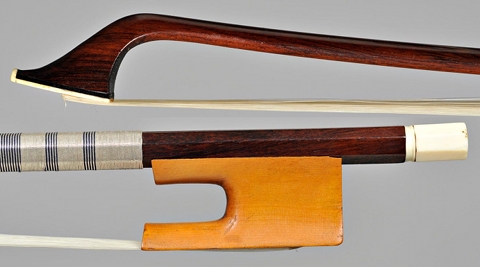NICOLAS LEONARD TOURTE dit "L'AINE"; THE BROTHER
Nicolas Leonard Tourte, wasn't very lucky in his life. Once settled with a long list of noble and wealthy clients, the French Revolution started. He also had the misfortune to be brother to the legendary, Francois Xavier Tourte. Despite this, he made an enormous contribution to modern bow making, which allows him to be considered among the most important bow makers in time.

Violin bow made of ivory, boxwood, and pernambuco, Nicolas Leonard Tourte
In the past, Francois Xavier Tourte, was given the full credit for having developed the modern bow, and he did contribute with a fundamental definition of the standard. However, I will venture to say that one of the most important cornerstones in the architecture of the modern bow, was introduced by Nicolas Leonard.
A brief biography
Nicolas Leonard was born in Paris, on the 22th of January 1746, and was son of Nicolas Pierre and the oldest brother to F.X.. He began to work in the family workshop when he was only 10 years old, and continued to do so, at least until the death of his father in 1764.
His life went through two phases:
Thanks to his skills and contacts, he became well known and appreciated in the exclusive and affluent circles in Freemasonry, and he was therefore able to clime the social ladder in the years 1764-1789.
In this period, he married twice. He married Catherine Landry, on the 21st of February 1767, with whom he had a son, Charles, who was later known as the bow maker "Tourte T". A few months after Catherine's death he married Marie Jeanne Guillaume Marion, on the 25th of November 1788, who was 23 years younger than him.
The deruote of Nicolas Leonards life, began when the French Revolution started. It took some time before the revolutionaries had guillotined the nobles, and still not satisfied, they began the persecution of those who had been particularly close to the nobility.
His first daughter, Marie Catherine Prudence, was born on the 16th of June 1790. He filed for a divorce, in 1794, in order to protect his wife and daughter from the fate that the revolution had brought him. The couple did not actually separate, and their second daughter, Madeleine Jeanne, was born on the 15th November of 1796. Their third daughter, Mélanie Joséphine Eléonore, was born on the 13th of September 1803.
The last years of his life, he lived trying to escape the retaliation of the revolutionaries. But probably failing to do that so, he died on the 11th of September 1807.
Analysis of the work
It is not easy to describe the style of a craftsman who started up making baroque bows with spear-formed heads and he ended up making modern bows. There are, though, some points that are more important than others in his work.
The first, and most important, was the adaptation of the "Cramer" model, in 1769. This particular model was fundamental in the evolution of the modern bow, because from this point on, the head had been raised and consequently the curves changed in a substantial way.
The dates are important, because in 1769, Francois Xavier was still working as a watch maker, and didn't become a dedicated bow maker until 1774. Therefore the intuition of this new mechanical model, was more due to Nicolas Leonard Tourte, than to F.X..
Even if the frogs are still too high in this model of bows, you will find the beginning of the modern concept as we know it today.
F.X., who was very experienced in working metal, did revolutionize the mechanism of the frog and so did Viotti later on in the early 1790'ies.
The innovation of the ring and the slide, and especially lowering the height of the frog was fundamental steps to the functionality of the modern bow, but the intuition that Nicolas Leonard had had to use the Cramer model, was the real turning point.
Nicolas Leonard died at the age of 61, and because he was persecuted for political reasons, he had already stopped bow making when he was 56. Although certainly less talented than his brother, no one will know what they could have achieved together. It is a fact that when he left the craft, he modern bow already existed.
Introducing you to this craftsman, I have the opportunity to introduce a technical topic I have never dealt with before. As you know, I do not occupy myself with baroque bows, because I find the modern bows much more fascinating. But I have realized that I have never explained the reason for which the changes were made.
Next week we shall deal with architecture - the architecture of bows, of course.
So long,
Paolo.
|